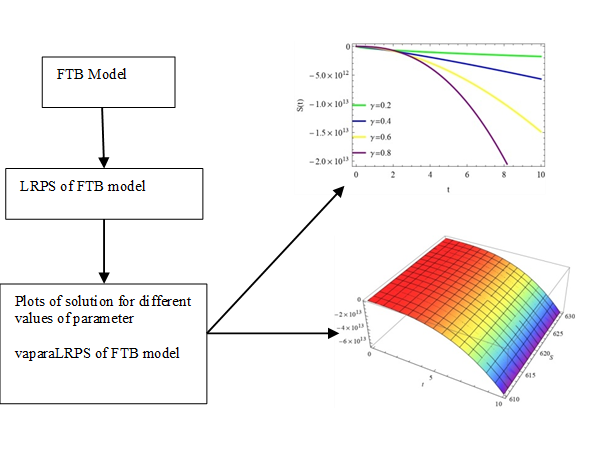Efficient Solutions with the LRPS Method for Non-Linear Fractional Order Tuberculosis Models
DOI:
https://doi.org/10.48048/tis.2024.7379Keywords:
Fractional order Tuberculosis mathematical model, Caputo’s derivative operator, Laplace residual power seriesAbstract
In this research article, we present a novel Non-Linear Fractional Order Tuberculosis mathematical model (NLFOTB) and introduce an efficient technique to obtain its solution. Fractional Order Models (FOMs) have garnered significant attention in contemporary research due to their widespread applicability. We address the challenge of solving the coupled Initial Value Problems (IVPs) associated with NLFOTB models by utilizing the groundbreaking LRPS method, which combines the RPS approach with the Laplace transform operator. This innovative approach generates approximate solutions in rapidly converging series forms, offering enhanced efficiency and reduced computational effort compared to conventional methods. Through the implementation of the LRPS method, we successfully derive an approximate solution for the NLFOTB model, contributing significantly to the field. Furthermore, our proposed approach demonstrates its efficacy in accurately capturing the dynamics of Tuberculosis (TB) through extensive computations and graphical representations, contributing to a deeper understanding of TB dynamics within a mathematical framework. Additionally, the LRPS method shows promise in tackling real world problems involving differential equations of various orders. Future investigations can extend the application of the LRPS method to explore other Fractional Order Models, further validating its effectiveness in a wide range of epidemic scenarios. Consequently, our study not only provides valuable insights into Tuberculosis dynamics but also introduces a powerful computational tool applicable to various practical problems in diverse disciplines, making a substantial contribution to the field of mathematical modeling and computation.
HIGHLIGHTS
· The comprehensive study highlights the LRPS strategy’s efficiency and accuracy in approximating solutions for fractional order equations. The research demonstrates its capability to predict compartmental behavior accurately within the specified range
· The discussions presented in the article significantly contribute to the field of epidemiology by introducing and showcasing the LRPS approach’s effectiveness. As a valuable tool for investigating and validating epidemic models, the LRPS method offers improved efficiency and convenience, thereby enhancing the understanding of disease dynamics
· The researchers anticipate that their findings will inspire further exploration and utilization of the LRPS technique in solving nonlinear models. This, in turn, is expected to contribute to advancements in the broader field of epidemiology, fostering continued innovation and development
GRAPHICAL ABSTRACT
Downloads
Metrics
References
S Banerjee. Mathematical modelling. CRC Press, New York, 2014.
World Health Organization. Tuberculosis. https://www.who.int/news-room/fact-sheets/detail/ tuberculosis
RX Armijos, MM Weigel, M Qincha and B Ulloa. The meaning and consequences of tuberculosis for an at-risk urban group in Ecuador. Revista Panamericana de Salud Pblica 2008; 23, 188-97.
SH Chang and JK Cataldo. A systematic review of global cultural variations in knowledge, attitudes and health responses to tuberculosis stigma. Int. J. Tuberc. Lung Dis. 2014; 18, 168-73.
D Okuonghae and SE Omosigho. Determinants of TB case detection in Nigeria: A survey. Global J. Health Sci. 2010; 2, 123-8.
P Dayan and LF Abbott. Theoretical neuroscience. MIT press, Cambridge, 2001.
A Kilbas, H Srivastava and J Trujillo. Theory and applications of fractional differential equations. Elsevier, Amsterdam, Netherlands, 2006.
AEKoufi and NE Koufi. Stochastic differential equation model of Covid-19: Case study of Pakistan. Results Phys. 2022; 34, 105218.
T Eriqat, A El-Ajou, MN Oqielat, Z Al-Zhour and S Momani. A new attractive analytic approach for solutions of linear and nonlinear neutral fractional pantograph equations. Chaos Solitons Fractals 2020; 138, 109957.
SS Zhou, S Rashid, S Parveen, AO Akdemir and Z Hammouch. New computations for extended weighted functionals within the Hilfer generalized proportional fractional integral operators. AIMS Math. 2021; 6, 4507-25.
M Jleli, S Kumar, R Kumar and B Samet. Analytical approach for time fractional wave equations in the sense of Yang-Abdel-Aty-Cattani via the homotopy perturbation transform method. Alexandria Eng. J. 2020; 59, 2859-63.
MAl-Smadi, OA Arqub and SHadid. Approximate solutions of nonlinear fractional Kundu-Eckhaus and coupled fractional massive Thirring equations emerging in quantum field theory using conformable residual power series method. Phys. Scripta 2020; 95, 105205.
A Ahmad, M Farman, F Yasin and MO Ahmad. Dynamical transmission and effect of smoking in society. Int. J. Adv. Appl. Sci. 2018; 5, 71-5.
AG Talafha, SM Alqaraleh, M Al-Smadi, S Hadid andS Momani. Analytic solutions for a modified fractional three wave interaction equations with conformable derivative by unified method. Alexandria Eng. J.2020; 59, 3731-9.
M Al-Qurashi, S Rashid, Y Karaca, Z Hammouch, D Baleanu and YM Chu. Achieving more precise bounds based on double and triple integral as proposed by generalized proportional fractional operators in the Hilfer sense. Fractals 2021; 29, 2140027.
S Hasan, A El-Ajou, S Hadid, M Al-Smadi and S Momani. Atangana-Baleanu fractional framework of reproducing kernel technique in solving fractional population dynamics system. Chaos Solitons Fractals 2020; 133, 109624.
S Rashid, Z Hammouch, D Baleanu and YM Chu. New generalizations in the sense of the weighted non-singular fractional integral operator. Fractals 2020; 28, 2040003.
M Al-Smadi, OA Arqub and D Zeidan. Fuzzy fractional differential equations under the Mittag-Leffler kernel differential operator of the ABC approach: Theorems and applications. Chaos Solitons Fractals 2021; 146, 110891.
M Al-Smadi, OA Arqub and S Momani. Numerical computations of coupled fractional resonant Schrödinger equations arising in quantum mechanics under conformable fractional derivative sense. Phys. Scripta 2020; 95, 075218.
R Almeida, D Tavares and D Torres. The variable-order fractional calculus of variations. Springer, Cham, Switzerland, 2019.
A Liu, F Yasin, Z Afzal and W Nazeer. Analytical solution of a non-linear fractional order SIS epidemic model utilizing a new technique. Alexandria Eng. J. 2023; 73, 123-9.
M Alaroud. Application of Laplace residual power series method for approximate solutions of fractional IVP’s. Alexandria Eng. J. 2022; 61, 1585-95.
H Dutta, A Akdemir and A Atangana. Fractional order analysis: Theory, methods and applications. John Wiley and Sons, New Jersey, 2020.

Downloads
Published
How to Cite
Issue
Section
License
Copyright (c) 2023 Walailak University

This work is licensed under a Creative Commons Attribution-NonCommercial-NoDerivatives 4.0 International License.






